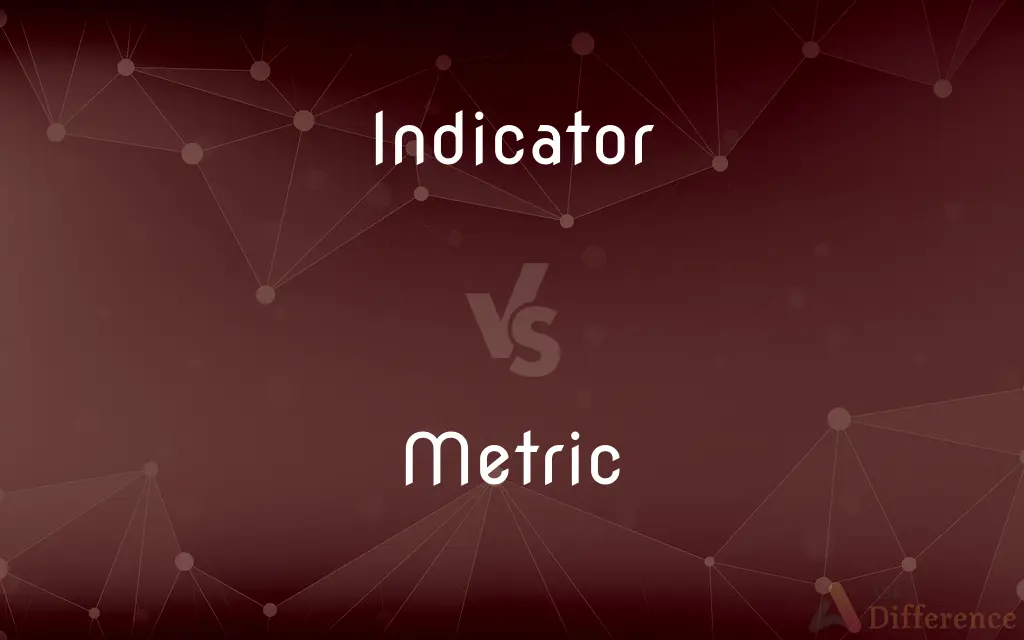Indicator vs. Metric — What's the Difference?
By Tayyaba Rehman & Urooj Arif — Updated on April 18, 2024
An indicator is a broad qualitative or quantitative measure that suggests the state or trend of a system; a metric is a specific, quantifiable measurement used to assess performance against a standard.

Difference Between Indicator and Metric
Table of Contents
ADVERTISEMENT
Key Differences
An indicator provides insights into a broader state or trend, potentially encompassing qualitative or quantitative elements. It's used to suggest rather than definitively measure performance or state. For instance, employee satisfaction can be an indicator of organizational health. On the other hand, a metric is specifically quantitative, providing precise data and measurements, like the number of sales in a quarter, that are used to assess and compare performance against defined objectives or standards.
While indicators can be seen as signs or suggestions of the state of a system and are often used in contexts where direct measurement is difficult, metrics offer concrete data points that allow for detailed analysis and benchmarking. Indicators might be used to gauge overall progress or trends, whereas metrics are typically used to measure specific aspects of performance and achieve certain goals.
In terms of application, an organization might use indicators to get a sense of overall direction or health, like tracking customer feedback as an indicator of service quality. Conversely, metrics might be used in a more focused manner, such as measuring the average response time to customer inquiries to assess efficiency and effectiveness.
Indicators are usually broader and can be subject to interpretation. They often serve as a preliminary measure that guides deeper analysis through specific metrics. For example, a high turnover rate might be an indicator of employee dissatisfaction, prompting a detailed metric-based analysis of aspects like work environment or compensation.
The role of indicators is often exploratory, helping to identify areas of concern or interest which can then be measured more precisely through metrics. Metrics, by contrast, are inherently tied to performance evaluation and decision-making processes, aimed at achieving predefined outcomes and improvements based on quantitative data.
ADVERTISEMENT
Comparison Chart
Nature
Can be qualitative or quantitative
Strictly quantitative
Purpose
Suggests trends or states, guides deeper analysis
Measures performance against objectives
Specificity
Broader and less specific
Highly specific and detailed
Interpretation
Subject to interpretation, provides general insights
Provides precise, often numerical data
Application
Used for initial assessments, broad overviews
Used for detailed analysis, performance tracking
Compare with Definitions
Indicator
Guides further measurement.
An indicator of high workload might lead to a detailed metric analysis of job distribution.
Metric
A quantifiable measure of performance.
Monthly sales figures are a key metric for retail performance.
Indicator
Often exploratory.
Declining sales can be an early indicator requiring detailed metric evaluation.
Metric
Always quantitative.
The metric of website traffic is measured in the number of visitors.
Indicator
A sign that points to a situation's state.
Employee engagement surveys serve as an indicator of workplace satisfaction.
Metric
Provides specific data.
Customer satisfaction can be quantified through a metric like Net Promoter Score.
Indicator
Can be qualitative.
Customer testimonials are indicators of client satisfaction.
Metric
Used for performance assessment.
Return on investment is a crucial metric for evaluating business success.
Indicator
Used for trend analysis.
Economic indicators help analysts predict market trends.
Metric
Integral to decision making.
Metrics on production efficiency influence operational adjustments.
Indicator
A thing that indicates the state or level of something
Car ownership is frequently used as an indicator of affluence
Metric
Of or relating to the metric system of measurement.
Indicator
A gauge or meter of a specified kind
An altitude indicator
A speed indicator
Metric
(music) Of or relating to the meter of a piece of music.
Indicator
A compound that changes colour at a specific pH value or in the presence of a particular substance, and can be used to monitor acidity, alkalinity, or the progress of a reaction
The remaining alkali is titrated against standard acid using phenolphthalein as indicator
Metric
Of or relating to distance.
Indicator
A pointer or an index.
Metric
A measure for something; a means of deriving a quantitative measurement or approximation for otherwise qualitative phenomena (especially used in engineering).
What metric should be used for performance evaluation?
What are the most important metrics to track for your business?
It's the most important single metric that quantifies the predictive performance.
How to measure marketing? Use these key metrics for measuring marketing effectiveness.
There is a lack of standard metrics.
Indicator
An instrument used to monitor the operation or condition of an engine, furnace, electrical network, reservoir, or other physical system; a meter or gauge.
Metric
(mathematics) A function for the measurement of the "distance" between two points in some metric space: it is a real-valued function d(x,y) between points x and y satisfying the following properties: (1) "non-negativity": , (2) "identity of indiscernibles": , (3) "symmetry": , and (4) "triangle inequality": .
Indicator
The needle, dial, or other registering device on such an instrument.
Metric
(mathematics) A metric tensor.
Indicator
(Chemistry) Any of various substances, such as litmus or phenolphthalein, that indicate the presence, absence, or concentration of another substance or the degree of reaction between two or more substances by means of a characteristic change, especially in color.
Metric
Abbreviation of metric system
Indicator
(Ecology) An indicator species.
Metric
To measure or analyse statistical data concerning the quality or effectiveness of a process.
We need to metric the status of software documentation.
We need to metric the verification of requirements.
We need to metric the system failures.
The project manager is metricking the closure of the action items.
Customer satisfaction was metricked by the marketing department.
Indicator
Any of various statistical values that together provide an indication of the condition or direction of the economy.
Metric
Relating to measurement; involving, or proceeding by, measurement.
Indicator
A pointer or index that indicates something.
Metric
Of or pertaining to the meter as a standard of measurement; of or pertaining to the decimal system of measurement of which a meter is the unit; as, the metric system; a metric measurement.
Indicator
A meter or gauge.
Metric
A function of a topological space that gives, for any two points in the space, a value equal to the distance between them
Indicator
The needle or dial on such a meter.
Metric
A decimal unit of measurement of the metric system (based on meters and kilograms and seconds);
Convert all the measurements to metric units
It is easier to work in metric
Indicator
(chemistry) Any of many substances, such as litmus, used to indicate the concentration of a substance, or the degree of a reaction.
Metric
A system of related measures that facilitates the quantification of some particular characteristic
Indicator
(ecology) A plant or animal whose presence is indicative of some specific environment.
Metric
Based on the meter as a standard of measurement;
The metric system
Metrical equivalents
Indicator
(economics) A measure, such as unemployment rate, which can be used to predict economic trends.
Metric
The rhythmic arrangement of syllables
Indicator
A turn signal; each of the flashing lights on each side of a vehicle which indicate a turn is being made to left or right, or a lane change etc.
Indicator
A bird, the honeyguide.
Indicator
One who, or that which, shows or points out; as, a fare indicator in a street car.
Indicator
A pressure gauge; a water gauge, as for a steam boiler; an apparatus or instrument for showing the working of a machine or moving part
Indicator
The part of an instrument by which an effect is indicated, as an index or pointer.
Indicator
Any bird of the genus Indicator and allied genera. See Honey guide, under Honey.
Indicator
That which indicates the condition of acidity, alkalinity, or the deficiency, excess, or sufficiency of a standard reagent, by causing an appearance, disappearance, or change of color, as in titration or volumetric analysis.
Indicator
A number or ratio (a value on a scale of measurement) derived from a series of observed facts; can reveal relative changes as a function of time
Indicator
A signal for attracting attention
Indicator
A device for showing the operating condition of some system
Indicator
(chemistry) a substance that changes color to indicate the presence of some ion or substance; can be used to indicate the completion of a chemical reaction or (in medicine) to test for a particular reaction
Common Curiosities
What is an indicator in performance measurement?
An indicator suggests the general state or trend within a system, offering insights that guide further analysis.
What defines a metric?
A metric is a specific, quantitative measurement used to assess performance against a standard or goal.
Why are metrics important in business?
Metrics provide the specific data needed to measure and enhance performance, crucial for achieving business objectives and making informed decisions.
Can a metric evolve from an indicator?
Yes, what starts as a broad indicator can lead to the development of specific metrics as more detailed data is required.
Can indicators be used alone for performance evaluation?
Indicators alone are less effective for precise performance evaluation; they are best used to guide more detailed metric analysis.
How are metrics integrated into performance management systems?
Metrics are integrated as key performance indicators (KPIs) to regularly assess and drive improvements in organizational performance.
How do industries vary in their use of indicators and metrics?
Different industries emphasize various indicators and metrics based on their unique operational goals and performance standards.
How do indicators differ from metrics?
Indicators are broader and can be qualitative or quantitative, providing general insights, whereas metrics are strictly quantitative and specific.
What role do indicators play in strategic planning?
Indicators help identify areas that need attention and guide strategic decision-making by highlighting trends and potential issues.
Is it possible for a metric to become an indicator?
Yes, a metric can sometimes become an indicator when used to suggest broader trends beyond its specific initial use.
What impact do indicators and metrics have on operational efficiency?
Indicators can signal areas needing improvement, and metrics can precisely measure the impact of changes made.
What are examples of indicators and metrics in healthcare?
Patient satisfaction surveys can serve as an indicator of service quality, while readmission rates are a metric for hospital performance.
How do you choose between an indicator and a metric?
Choose indicators to get a broad sense of a situation and metrics to obtain precise measurements for specific aspects of performance.
Are there technological tools to track indicators and metrics?
Yes, various business intelligence and analytics tools are designed to track and analyze both indicators and metrics.
What are the limitations of using indicators and metrics?
Indicators may be too vague to base decisions on alone, while metrics may not capture the broader context affecting performance.
Share Your Discovery

Previous Comparison
Dwelling vs. Living
Next Comparison
Again vs. AnymoreAuthor Spotlight
Written by
Tayyaba RehmanTayyaba Rehman is a distinguished writer, currently serving as a primary contributor to askdifference.com. As a researcher in semantics and etymology, Tayyaba's passion for the complexity of languages and their distinctions has found a perfect home on the platform. Tayyaba delves into the intricacies of language, distinguishing between commonly confused words and phrases, thereby providing clarity for readers worldwide.
Co-written by
Urooj ArifUrooj is a skilled content writer at Ask Difference, known for her exceptional ability to simplify complex topics into engaging and informative content. With a passion for research and a flair for clear, concise writing, she consistently delivers articles that resonate with our diverse audience.














































